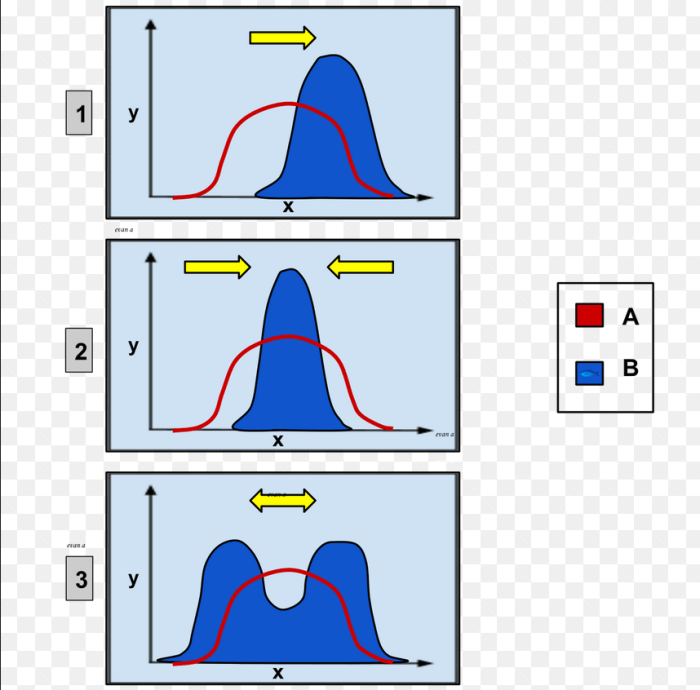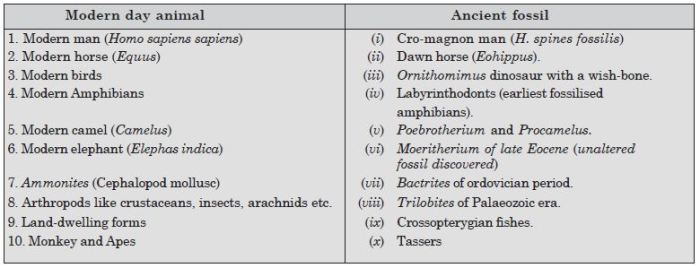Embark on an extraordinary voyage with wlhs biology unit 7 evolution, where we unravel the captivating tapestry of life’s transformative journey. Join us as we explore the intricacies of natural selection, genetic variation, and the mechanisms that have shaped the diversity of life on Earth.
From fossil records to molecular biology, we delve into the compelling evidence that supports the theory of evolution. Prepare to be amazed by the intricate designs of homologous and analogous structures, revealing the interconnectedness of all living organisms.
Evolutionary Theory and Principles

Evolution refers to the gradual change in the inherited traits of biological populations over generations. It is a fundamental concept in biology, explaining the diversity and complexity of life on Earth.
Key principles of evolution include:
- Descent with Modification:All living organisms share a common ancestor and have evolved over time.
- Natural Selection:Individuals with advantageous traits have a higher chance of survival and reproduction, passing on their traits to the next generation.
- Genetic Variation:Genetic differences within a population provide the raw material for natural selection to act upon.
Role of Natural Selection
Natural selection is the driving force behind evolution. It favors individuals with traits that enhance their survival and reproductive success in their specific environment.
Natural selection operates through the following steps:
- Variation:Genetic variation exists within a population.
- Differential Survival:Individuals with advantageous traits have a higher chance of surviving.
- Differential Reproduction:Surviving individuals pass on their advantageous traits to their offspring.
Over generations, natural selection gradually increases the frequency of advantageous traits in a population, leading to evolutionary change.
Genetic Variation
Genetic variation provides the raw material for natural selection to work upon. It arises from various sources, including:
- Mutation:Random changes in the genetic code.
- Genetic Recombination:Mixing of genetic material during sexual reproduction.
- Gene Flow:Transfer of genes between populations.
Genetic variation ensures that no two individuals are genetically identical, providing the diversity necessary for evolution.
To delve deeper into the intricacies of evolution, I recommend exploring the Congress in a Flash Worksheet . This resource offers a comprehensive overview of the topic, enhancing your understanding of natural selection, genetic drift, and other evolutionary mechanisms. By incorporating this resource into your study of Wlhs Biology Unit 7 Evolution, you’ll gain a more nuanced perspective on the transformative processes that have shaped life on Earth.
Evidence for Evolution
The theory of evolution is a well-supported scientific concept that explains the diversity and adaptations of life on Earth. This theory is based on a wealth of evidence from various fields of biology, including fossil records, comparative anatomy, and molecular biology.
Fossil Records
Fossil records provide a glimpse into past life forms and offer direct evidence of evolutionary change. Fossils show that organisms have gradually changed over time, and that new species have emerged from pre-existing ones. For example, the fossil record of horses shows a gradual transition from small, three-toed ancestors to the modern horse with a single hoof.
Comparative Anatomy
Comparative anatomy examines the similarities and differences in the anatomical structures of different organisms. Homologous structures are structures that share a common ancestry, even if they serve different functions. For example, the forelimbs of humans, bats, and whales are homologous structures that evolved from a common ancestor.
Analogous structures, on the other hand, are structures that serve similar functions but do not share a common ancestry. For example, the wings of bats and birds are analogous structures that evolved independently to facilitate flight.
Molecular Biology
Molecular biology studies the genetic material of organisms. DNA and protein sequences can be compared to determine the evolutionary relationships between species. The more similar the DNA or protein sequences, the more closely related the species are. This evidence supports the theory of evolution by showing that organisms that share a common ancestor have similar genetic material.
Mechanisms of Evolution: Wlhs Biology Unit 7 Evolution
Evolution, the fundamental principle driving the diversity of life, is not a haphazard process. It operates through a set of well-defined mechanisms that shape the genetic composition of populations over time. These mechanisms, working in concert, alter the frequencies of alleles, the alternative forms of genes, leading to the gradual accumulation of genetic changes.
Three primary mechanisms of evolution are mutation, genetic drift, and gene flow.
Mutation
Mutations are random changes in the DNA sequence that introduce new genetic material or alter existing ones. These changes can range from minor alterations in a single nucleotide to large-scale chromosomal rearrangements. Mutations provide the raw material upon which other evolutionary mechanisms can act.
Genetic Drift
Genetic drift is the random fluctuation of allele frequencies within a population, particularly in small populations. It can lead to the loss of alleles or the fixation of certain alleles, even if they are not necessarily advantageous. Genetic drift is more pronounced in smaller populations due to the reduced likelihood of an individual carrying a specific allele.
Gene Flow
Gene flow is the transfer of genetic material between populations. It occurs through the movement of individuals, such as migration or interbreeding. Gene flow can introduce new alleles into a population or alter the existing allele frequencies, influencing the genetic composition of the recipient population.
Patterns of Evolution
Evolutionary processes can lead to diverse patterns of change in populations and species over time. These patterns shape the biodiversity we observe today.
Convergent Evolution
Convergent evolution occurs when unrelated species independently evolve similar traits in response to similar environmental pressures. This results in analogous structures that perform similar functions.
- Example:Streamlined body shape in fish, dolphins, and penguins for efficient swimming
Divergent Evolution
Divergent evolution occurs when a population of a species splits into two or more distinct lineages that evolve along different trajectories. This can lead to the formation of new species.
- Example:Evolution of different beak shapes in Darwin’s finches based on their feeding habits
Coevolution
Coevolution occurs when two or more species interact closely over evolutionary time, leading to reciprocal adaptations that influence each other’s evolution.
- Example:Mutualistic relationship between flowering plants and pollinating insects
Human Evolution
Human evolution refers to the evolutionary history of the human species, from early hominids to modern humans. It involves the biological and behavioral changes that have occurred over millions of years, leading to the development of distinct human characteristics and adaptations.
Early Hominids
The evolutionary journey of humans began with early hominids, ape-like creatures that emerged around 6 million years ago. Key adaptations during this stage included bipedalism (walking upright), increased brain size, and the development of stone tools. Examples of early hominids include Sahelanthropus tchadensis and Australopithecus afarensis (Lucy).
Homo Species
Around 2.8 million years ago, the Homo genus emerged, characterized by larger brains, more complex toolmaking abilities, and increased social cooperation. Homo habilis, Homo erectus, and Homo neanderthalensis are notable examples.
Modern Humans (Homo sapiens)
Modern humans (Homo sapiens) emerged in Africa around 300,000 years ago. They possessed advanced cognitive abilities, language, and cultural practices. Homo sapiens migrated out of Africa and spread across the globe, eventually replacing other hominid species.
Key Adaptations and Milestones
Throughout human evolution, several key adaptations and milestones have shaped our species:
Bipedalism
Walking upright freed up the hands for tool use and facilitated long-distance travel.
Enlarged brain
Increased brain size allowed for complex cognitive abilities, problem-solving, and language development.
Toolmaking
The ability to create and use tools enhanced survival, hunting, and food processing.
Social cooperation
Humans evolved as highly social creatures, cooperating in hunting, gathering, and raising offspring.
Cultural transmission
The ability to learn and pass on knowledge and skills through generations accelerated human progress.
Evolution and Society

Evolutionary theory has far-reaching implications beyond the realm of biology. It has shaped our understanding of human nature, society, and the world around us. This section explores the social and ethical implications of evolutionary theory and discusses how evolutionary principles have influenced various fields such as medicine, psychology, and education.
Social Implications
- Cooperation and Altruism:Evolutionary theory suggests that cooperation and altruism have evolved as survival strategies. Individuals who cooperate with others and help those in need are more likely to pass on their genes.
- Social Hierarchy:Evolutionary theory has been used to explain the existence of social hierarchies in human societies. It suggests that competition for resources and the need for leadership have led to the development of dominance structures.
- Culture and Language:Evolutionary theory has helped us understand the origins and evolution of culture and language. These traits are seen as adaptations that have evolved to enhance communication and cooperation within groups.
Ethical Implications
- Eugenics:Evolutionary theory has been misused in the past to justify eugenics, the practice of selective breeding to improve the human gene pool. This practice is now widely condemned as unethical.
- Genetic Engineering:The advent of genetic engineering raises ethical questions about the potential to alter human genes and the implications for future generations.
- Responsibility and Stewardship:Evolutionary theory reminds us of our connection to all living things and our responsibility to act as stewards of the planet.
Evolutionary Principles in Other Fields, Wlhs biology unit 7 evolution
Evolutionary principles have also had a significant impact on other fields:
- Medicine:Evolutionary theory has helped us understand the origins and spread of diseases and has led to the development of new treatments.
- Psychology:Evolutionary psychology explores how evolutionary processes have shaped human behavior and cognition.
- Education:Evolutionary theory has implications for teaching and learning, suggesting that students may learn best when presented with information in a way that aligns with their evolved cognitive abilities.
Commonly Asked Questions
What is the central concept of wlhs biology unit 7 evolution?
The central concept of wlhs biology unit 7 evolution is the theory of evolution, which explains how species change and diversify over time through natural selection and genetic variation.
What are the different mechanisms of evolution discussed in this unit?
The mechanisms of evolution covered in this unit include mutation, genetic drift, and gene flow, which contribute to changes in allele frequencies and genetic diversity.
How does wlhs biology unit 7 evolution relate to human evolution?
This unit provides insights into human evolution by tracing the evolutionary history of humans, examining key adaptations, and discussing the impact of evolutionary principles on fields like medicine and psychology.